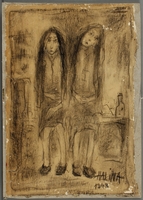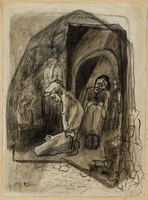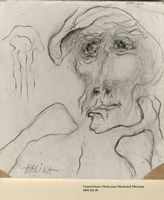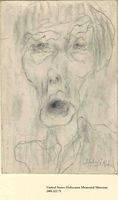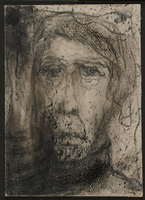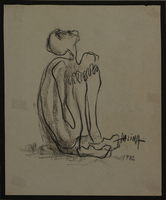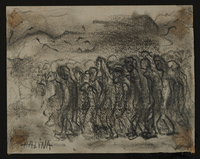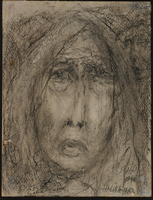Overview
- Brief Narrative
- Abstract portrait of a woman with black hair and red lips, dark circle and blue lines around face, mounted on cardboard
- Artwork Title
- The second generation (She remembers too)
- Credit Line
- United States Holocaust Memorial Museum Collection
- Contributor
-
Halina Olomucki
- Biography
-
Halina Olszewski (later Olomucki/Olomucka) was born on November 24, 1919, in Warsaw, Poland, to Andrzej and Margarit-Hadassa Olszewski. She had an older brother, Moniek, born in 1909, and two sisters. Her parents ran a newspaper distribution service. Her father died in 1924. The family was Jewish but not observant. Halina attended a Yiddish speaking elementary school, then a public gymnasium.
Poland was invaded by Nazi Germany on September 1, 1939. German troops entered Warsaw on September 29. Halina and her family were relocated to the ghetto. Jews had to wear armbands with Judenstern, valuables were confiscated, and forced labor was required. Halina had drawn constantly from an early age and she continued to do this in the ghetto. She felt an urgent need to record daily life, even though, as she recalled: "I was in the same condition as every other person all around me. I saw them close to death but I never thought of myself close to death.... My job was simply to write down, to draw what was happening." Halina depicted the misery and suffering of life in the ghetto, where nearly 100,000 people died within the first fifteen months from disease and starvation. She also recorded events such as selections, deportations from the Umschlagplatz, or holding place, near the railroad station, and the destruction of Dr. Janos Korczak’s orphanage. While doing forced labor outside the ghetto, Halina smuggled drawings out to a Polish friend in the Aryan section, dropping small packages of drawings as her brigade walked by. On some occasion, Halina also smuggled in food for her family
In May 1943, after three days of waiting in the Umschlagplatz without food or water, Halina and her mother were put into a crowded train car and taken to Majdanek concentration camp. Her mother was sent to be killed upon arrival. Halina survived four selections done to separate those to be gassed from those to be used as laborers. One day, a guard came into the barracks and asked if there was anyone who knew how to paint and Halina volunteered. The work was drawing slogans on the walls, for which she received coffee and several slices of bread. The camp administrators liked her work and found other art projects for her. In July 1943, Halina was transferred to Auschwitz-Birkenau where she was tattooed with the number 48652. She was assigned to Block 10 whose residents were used for experimental medical atrocities. Halina was a slave laborer in an ammunition factory, and then was assigned to paint signs and slogans for the barracks. The slogans were about things like keeping clean and washing your hands, even though there was not even water to drink, much less wash, and living conditions were primitive and filthy. She also did sketches for the SS guards. She received increased rations of bread and cheese which she believed kept her alive. Halina hid pencil stubs and supplies from work, and secretly drew on any paper she could find, tissue and cigarette rolling paper, or scraps of discarded graph paper and reports. She had watercolors, but brushes had to be fashioned from cardboard strips. She made works based on her observations of the people and activities around her. Many prisoners implored her to draw their portraits believing that Halina was likely to survive. She hid her drawings in different spots around the camp, and in floors and walls near her bunk. She destroyed many works because of the constant fear of discovery. Halina was beaten often, and after the October 1944 revolt, spent days standing for exhaustive rolls calls and watched friends being murdered by guards. As Soviet forces neared, the camp was evacuated by death march on January 18, 1945, to Ravensbrück, and then to Neustadt-Glewe, where Halina was liberated by the Allies on May 2, 1945.
Halina returned to Warsaw after the war ended in May. She found no surviving family members. She recovered drawings she had smuggled out of Warsaw Ghetto and later some works from Birkenau. From 1945-1947, she created artworks as her eyewitness testimony of all she had seen and experienced during the Shoah. In 1945, she married Boleslaw Olomucki, who became an architect, with training from the Art Academy in Łódź and Warsaw Polytechnic. Boleslaw, born in Łódź on November 10, 1921, had been interned in the ghetto in 1940. On August 27, 1944, he was sent to Auschwitz-Birkenau concentration camp, then in October, transferred to Braunschweig/Neuengamme as slave labor. In March 1945, he was sent on a death march to Ravensbrück, then to Wobbelin where he was liberated. The couple moved to Łódź, where Halina studied at the Art Academy until 1950. The first exhibition of her artwork was in 1949 in Warsaw. She and Boleslaw had a daughter Miriam in 1951. In 1957, the family moved to Paris, France. Halina exhibited widely in Paris and London during the 1960s. In 1972, the family immigrated to Israel. Halina, 87, passed away on April 9, 2007, in Ashkelon, Israel.
Physical Details
- Classification
-
Art
- Category
-
Drawings
- Object Type
-
Pencil drawing (lcsh)
- Dimensions
- overall: Height: 11.120 inches (28.245 cm) | Width: 8.380 inches (21.285 cm)
- Materials
- overall : cardboard, paper, mixed media, wash, paint
Rights & Restrictions
- Conditions on Access
- No restrictions on access
- Conditions on Use
- No restrictions on use
Keywords & Subjects
- Topical Term
- Holocaust, Jewish (1939-1945), in art.
Administrative Notes
- Legal Status
- Permanent Collection
- Provenance
- The drawing was acquired by the United States Holocaust Memorial Museum in 2001.
- Record last modified:
- 2022-07-28 18:28:13
- This page:
- https://collections.ushmm.org/search/catalog/irn509472
Download & Licensing
In-Person Research
- By Appointment
- Request 21 Days in Advance of Visit
- Plan a Research Visit
- Request to See This Object
Contact Us
Also in Halina Olomucki collection
The collection consists of 147 drawings, 47 oil paintings, and 135 mixed material pieces of artwork created by Halina Olomucki based upon her experiences in the Warsaw ghetto in Poland and as a prisoner and death march survivor of Majdanek, Auschwitz-Birkenau, Ravensbruck, and Neustadt concentration camps during the Holocaust.
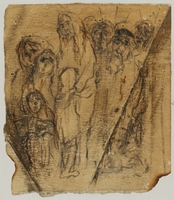
Autobiographical drawing by Halina Olomucki of people waiting in line in the Warsaw ghetto
Object
Pencil sketch created by 23 year old Halina Olszewski (later Olomucki) in the Warsaw ghetto in 1942. Following Germany's invasion of Poland on September1, 1939, Halina and her family were relocated to the ghetto. In May 1943, Halina and her mother, Margalit-Hadassa, were deported to Majdanek concentration camp, where her mother was killed upon arrival. In July, Halina was sent to Auschwitz-Birkenau. During all this time, she continued to create drawings. The camp was evacuated by death march on January 18, 1945, to Ravensbrück. Halina was then sent to Neustadt-Glewe, where she was liberated by the Allies in May 1945. Halina returned to Poland where, from 1945-1947, she created works that present remarkable eyewitness testimony of what she had seen and experienced during the Shoah.
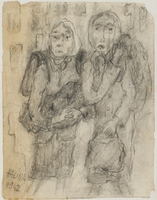
Autobiographical drawing by Halina Olomucki of two women in the Warsaw ghetto
Object
Pencil sketch created by 23 year old Halina Olszewski (later Olomucki) in the Warsaw ghetto in 1942. Following Germany's invasion of Poland on September1, 1939, Halina and her family were relocated to the ghetto. In May 1943, Halina and her mother, Margalit-Hadassa, were deported to Majdanek concentration camp, where her mother was killed upon arrival. In July, Halina was sent to Auschwitz-Birkenau. During all this time, she continued to create drawings. The camp was evacuated by death march on January 18, 1945, to Ravensbrück. Halina was then sent to Neustadt-Glewe, where she was liberated by the Allies in May 1945. Halina returned to Poland where, from 1945-1947, she created works that present remarkable eyewitness testimony of what she had seen and experienced during the Shoah.
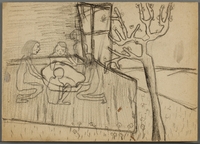
Autobiographical sketch by Halina Olomucki of naked children gathered around an empty basin
Object
Crude pencil sketch created by 23 year old Halina Olszewski (later Olomucki) in the Warsaw ghetto in 1942. Following Germany's invasion of Poland on September1, 1939, Halina and her family were relocated to the ghetto. In May 1943, Halina and her mother, Margalit-Hadassa, were deported to Majdanek concentration camp, where her mother was killed upon arrival. In July, Halina was sent to Auschwitz-Birkenau. During all this time, she continued to create drawings. The camp was evacuated by death march on January 18, 1945, to Ravensbrück. Halina was then sent to Neustadt-Glewe, where she was liberated by the Allies in May 1945. Halina returned to Poland where, from 1945-1947, she created works that provide eyewitness testimony of what she had seen and experienced during the Shoah.
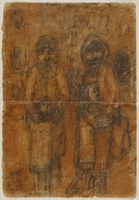
Halina Olomucki drawing
Object
Image of three standing adults holding two children, mounted on cardboard and construction paper
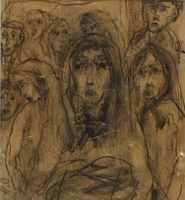
Autobiographical drawing by Halina Olomucki of a woman receiving a parcel in the Warsaw ghetto
Object
Pencil and ink sketch created by 24 year old Halina Olszewski (later Olomucki) in the Warsaw ghetto in 1943. Following Germany's invasion of Poland on September1, 1939, Halina and her family were relocated to the ghetto. In May 1943, Halina and her mother, Margalit-Hadassa, were deported to Majdanek concentration camp, where her mother was killed upon arrival. In July, Halina was sent to Auschwitz-Birkenau. During all this time, she created drawings. The camp was evacuated by death march on January 18, 1945, to Ravensbrück. Halina was then sent to Neustadt-Glewe, where she was liberated by the Allies in May 1945. Halina returned to Poland where, from 1945-1947, she created works to provide detailed eyewitness testimony of what she had seen and experienced during the Shoah.

Halina Olomucki drawing
Object
Image of building complex with train tracks leading towards arched entrance tower, mounted on cardboard

Halina Olomucki drawing
Object
Rectangular form; horizontal format; exterior scene, black and white image of children dancing and holding hands among flowers with sun shining; adhered to painted cardboard mount

Halina Olomucki drawing
Object
Rectangular form; horizontal format; exterior scene, black and white image of building with central tower and arch entryway, railroad tracks at entrance; adherred to paper mount
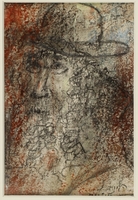
Halina Olomucki drawing
Object
Rectangular form; vertical format; black and white image of man wearing tattered clothes and cap with box containing Star of David armbands around his shoulder; adhered to construction paper mount
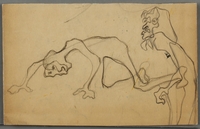
Halina Olomucki drawing
Object
Rectangular form; horizontal image; recto, black and white graphite image with black colored pencil details of figure on hands and knees while another figure stands off to side; verso, black and white colored pencil abstract image

Halina Olomucki drawing
Object
Square form; vertical format; black and white graphite image with black colored pencil details of woman seated in center of group of figures with baby lying in her arms; adhered to cardboard mount

Halina Olomucki drawing
Object
Image of standing woman holding two children in front of a building, mounted on cardboard and construction paper
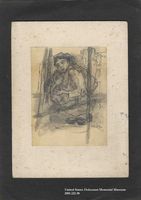
Halina Olomucki drawing
Object
Image of crouching woman holding baby, mounted on cardboard and construction paper

Halina Olomucki drawing
Object
Rectangular form; vertical format; exterior scene, black and white image of two smiling women walking with arms around one another; adhered to cardboard mount
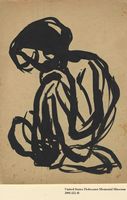
Halina Olomicki abstract drawing of a woman
Object
Abstract onk drawing of a seted female figure created by Halina Olszewski (later Olomucki) after the war. Halina was a native of Warsaw, Poland. In September 1939, Nazi Germany occupied Poland, and established the ghetto in October 1940. Halina, her mother Margarit-Hadassa, and brother Moniek were relocated there. Hannah did forced labor outside the ghetto, but she felt her real job was to draw what was happening in the ghetto. By the end of 1941, starvation, disease, and death were widespread. Halina smuggled many drawings to friends outside the ghetto. In May 1943, she and her mother were deported to Majdanek in May 1943. Her mother was killed on arrival, but Halina was sent to Auschwitz-Birkenau, where she continued to create art. On January 18, 1945, she was sent by death march to Neustadt-Glewe, where she was liberated by the Allies on May 2, 1945. She returned to Warsaw and found that no family members had survived.
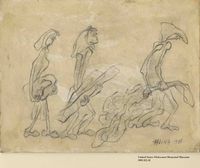
Halina Olomucki drawing
Object
Rectangular form; horizontal format; black and white image of three figures dragging and carrying logs and rocks; adhered to cardboard mount

Halina Olomucki drawing
Object
Rectangular form; vertical format; black and white image of figure sitting with hands resting on knees and head tilted backwards staring upwards; adhered to cardboard mount

Halina Olomucki drawing
Object
Abstract portrait with a large orange and yellow sun in upper right corner

Halina Olomucki drawing
Object
Abstract image of a central portrait of a woman with girl with various figures in the background

Halina Olomucki drawing
Object
Abstract image of several female figures standing and sitting outside of a building

Halina Olomucki drawing
Object
Abstract portrait of a woman wearing a kerchief and facing to the left

Halina Olomucki drawing
Object
Abstract image of a woman wearing a kerchief and looking towards the viewer

Halina Olomucki drawing
Object
Abstract image of a woman wearing a large kerchief and facing to the left, sun in upper left corner.

Halina Olomucki drawing
Object
Abstract image of a woman with long hair, buildings in the background
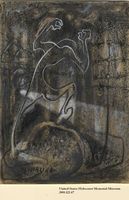
Halina Olomucki drawing
Object
Abstract image of a figure climbing up onto sacks to reach the barbed wires

Halina Olomucki drawing
Object
Abstract image of a multi-armed and multi-legged figure climbing up on to the barbed wire

Halina Olomucki drawing
Object
Abstract image of a man with a long beard, buildings in the background, mounted on cardboard

Halina Olomucki drawing
Object
Abstract portrait of a woman, long red hair and tear on cheek, blue background, mounted on cardboard and construction paper

Halina Olomucki drawing
Object
Abstract portrait of a woman facing forward, blue background, on cardboard

Halina Olomucki drawing
Object
Abstract image of group of walking figures, military figures in green uniforms at front and back, thick black lines
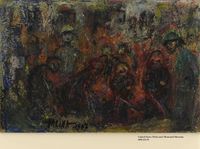
Halina Olomucki drawing
Object
Abstract image of central group of sitting figures, two standing figures in green, orange and red colors predominate

Halina Olomucki drawing
Object
Abstract image of group of standing figures, buildings in background, round orange object in bottom left corner

Halina Olomucki drawing
Object
Abstract iamge of two groups of figures on the left and right, military figure in green standing with each group, building in background
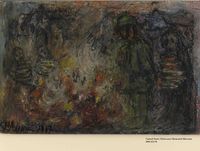
Halina Olomucki drawing
Object
Abstract image of standing military figure in green with orange-red flames, other figures in background

Halina Olomucki drawing
Object
Abstract image in bright colors with raised surface design, mounted on cardboard

Halina Olomucki drawing
Object
Abstract image of group of figures walking towards double-chimney structure, mounted on cardboard

Halina Olomucki drawing
Object
Portrait of a woman with a haggard expression, blue details on blouse, orange background, mounted on cardboard
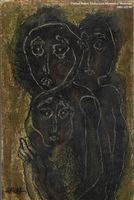
Halina Olomucki drawing
Object
Abstract image of three standing figures with large, round staring eyes, mounted on cardboard.

Halina Olomucki drawing
Object
Abstract portrait of woman in broad areas of bright colors, mounted on paper and then on construction paper
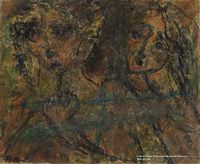
Halina Olomucki drawing
Object
Abstract image of two women behind blue-colored barbed wire, mounted on cardboard
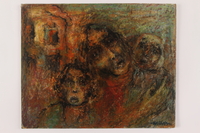
Halina Olomucki drawing
Object
Abstract portraits of three figures with buildings on left, broad areas of bright colors, mounted on cardboard
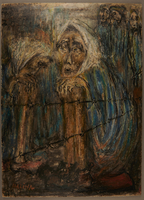
Halina Olomucki drawing
Object
Abstract image of two crouching women with standing group of women behind them, two strands of barbed wire in front, mounted on cardboard

Halina Olomucki drawing
Object
Abstract image of two figures behind intersecting branch-like lines, graphite drawing of woman on back of paper.
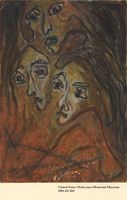
Halina Olomucki drawing
Object
Abstract image of three figures above orange-red flames, mounted on cardboard

Halina Olomucki drawing
Object
Abstract image of two figures with large clutching arms and hands on the right, red flames below, mounted on cardboard
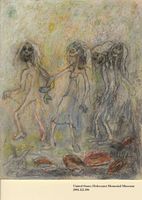
Halina Olomucki drawing
Object
Abstract image of four female figures walking along arm in arm, mounted on cardboard

Halina Olomucki drawing
Object
Abstract portrait of a figure in profile, yellow sun in upper left corner, mounted on cardboard
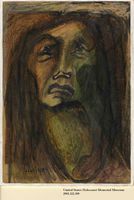
Halina Olomucki drawing
Object
Abstract portrait of a figure with long broad lines and orange and green colors, mounted on cardboard

Halina Olomucki drawing
Object
Portrait of a woman with a long face, long hair and looking sideways, mounted on cardboard
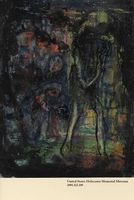
Halina Olomucki drawing
Object
Abstract image of standing and sitting figures, black ink border and raised areas, mounted on cardboard

Halina Olomucki drawing
Object
Abstract image of stooped-over figures in orange-red holding parcels, buildings behind, mounted on cardboard

Halina Olomucki drawing
Object
Abstract portrait of a woman with large eyes and long hair, green and blue background, mounted on cardboard

Halina Olomucki painting
Object
Abstract portrait of a woman with orange and green colors and loose strokes, mounted on cardboard
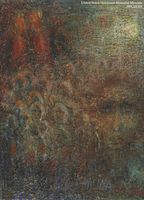
Halina Olomucki drawing
Object
Abstract image of a group of standing figures (and one portrait), two orange-red towers in the upper left, yellow sun in upper right, mounted on cardboard
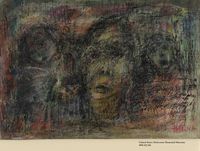
Halina Olomucki drawing
Object
Abstract image of three portraits with multicolored background, mounted on cardboard

Halina Olomucki drawing
Object
Abstract image of a family group with a man with a long beard in the center, mounted on cardboard
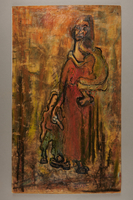
Halina Olomucki drawing
Object
Abstract image of standing woman holding one child while another stands by her side, holding her hand, mounted on cardboard

Halina Olomucki drawing
Object
Portrait of a woman with her arms crossed, black border, mounted on cardboard
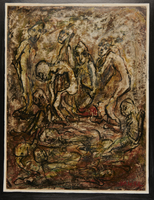
Halina Olomucki painting
Object
Abstract image of writhing figures both standing and lying on the ground, mounted on cardboard and on another black painted cardboard
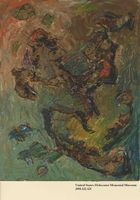
Halina Olomucki drawing
Object
Abstract image of a figure running painted in thick strokes (areas missing)

Halina Olomucki painting
Object
Abstract image of crouching woman with another group of figures in right background, mounted on cardboard
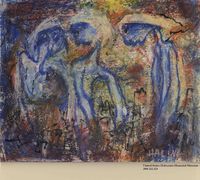
Halina Olomucki drawing
Object
Abstract image of three elongated figures drawn in wide blue lines, mounted on cardboard
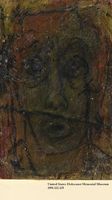
Halina Olomucki drawing
Object
Abstract portrait of figure behind barbed wire with orange and green colors, mounted on cardboard

Halina Olomucki drawing
Object
Abstract portrait of a woman with long hair, multi-colored background, mounted on cardboard

Halina Olomucki drawing
Object
Abstract portrait of a woman with down-turned mouth, in orange and green colors, mounted on cardboard

Halina Olomucki drawing
Object
Abstract portrait of a long, haggard face painted in black strokes, mounted on cardboard

Halina Olomucki drawing
Object
Abstract image of woman with large dark eyes holding child to her face, mounted on cardboard
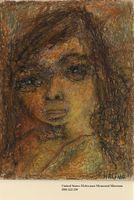
Halina Olomucki drawing
Object
Abstract portrait of a child with large eyes, orange-red background, mounted on cardboard
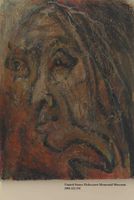
Halina Olomucki drawing
Object
Abstract portrait of old woman with gaunt features, orange-red background, mounted on cardboard
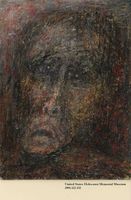
Halina Olomucki drawing
Object
Abstract portrait with down-turned mouth, dark eyes and red background, mounted on cardboard

Halina Olomucki drawing
Object
Abstract portrait of a woman in graphite with orange and blue background, mounted on cardboard
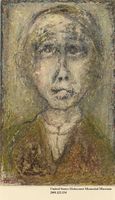
Halina Olomucki drawing
Object
Abstract portrait of boy with blue border and yellow-green clothing, mounted on cardboard
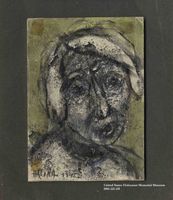
Halina Olomucki drawing
Object
Abstract portrait of a woman in broad black lines, white hair and green background, mounted on cardboard and construction paper

Halina Olomucki drawing
Object
Abstract portrait of a woman with long hair, red cheeks and lips, yellow-green background, mounted on cardboard

Halina Olomucki drawing
Object
Abstract portrait of a woman standing in front of a building with a window, yellow sun in upper left corner, mounted on cardboard

Halina Olomucki drawing
Object
Abstract portrait of a haggard man with large dark eyes, red sun in upper left corner, mounted on cardboard
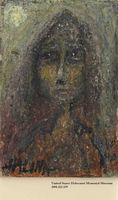
Halina Olomucki drawing
Object
Abstract portrait of a girl with long hair and thin neck, light yellow sun in upper left corner, mounted on cardboard

Halina Olomucki drawing
Object
Abstract image of a thin figure lying in a bed with a seated figure on the right, mounted on cardboard
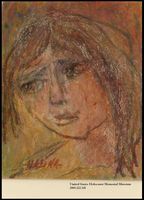
Halina Olomucki drawing
Object
Abstract portrait of a girl looking side ways, orange-yellow background, mounted on cardboard

Autobiographical drawing by Halina Olomucki of a group of people crowded into a small space
Object
Pencil sketch created by 28 year old Halina Olomucki in 1947 in Łódź, Poland. Following Germany's invasion of Poland on September1, 1939, Halina and her family were relocated to the Warsaw ghetto. In May 1943, Halina and her mother, Margalit-Hadassa, were deported to Majdanek concentration camp, where her mother was killed upon arrival. In July, Halina was sent to Auschwitz-Birkenau. During all this time, she continued to create drawings. The camp was evacuated by death march on January 18, 1945, to Ravensbrück. Halina was then sent to Neustadt-Glewe, where she was liberated by the Allies in May 1945. Halina returned to Poland where, from 1945-1947, she created works that present powerful eyewitness testimony of what she had seen and experienced during the Shoah.
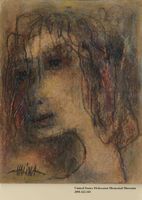
Halina Olomucki drawing
Object
Abstract portrait of a girl with long, thin hair facing sideways, mounted on cardboard
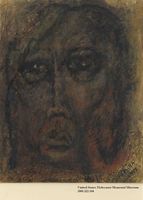
Halina Olomucki drawing
Object
Abstract portrait of a woman in dark tones and black lines, mounted on cardboard
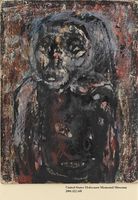
Halina Olomucki drawing
Object
Abstract image of an old woman wearing a kerchief, in broad black lines, mounted on cardboard

Halina Olomucki drawing
Object
Abstract image of a woman with long hair, round head and large grin, "libre!", mounted on cardboard
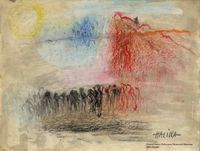
Halina Olomucki drawing
Object
Abstract image of a group of moving figures, large yellow sun in upper left corner, large orange-red structure on right side, mounted on cardboard
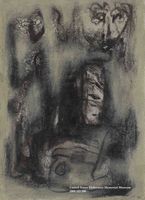
Halina Olomucki drawing
Object
Abstract image with dark geometric shapes and a face in the upper right corner, mounted on cardboard

Halina Olomucki drawing
Object
Abstract image with a central group of huddled figures, four colored circles in top half of image with multi-colored square, mounted on cardboard
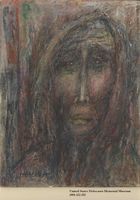
Halina Olomucki drawing
Object
Abstract portrait of a woman with haggard expression, multi-colored background, mounted on cardboard

Halina Olomucki drawing
Object
Abstract portrait of two men with long hair, orange-red background, mounted on cardboard

Halina Olomucki drawing
Object
Abstract image showing a woman's head in the lower left corner and two tall red structures with flames on the right, mounted on cardboard

Halina Olomucki drawing
Object
Abstract image of a girl with her head titled sideways leaning on her arm, mounted on cardboard
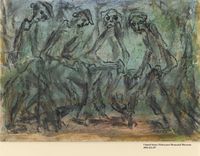
Halina Olomucki drawing
Object
Abstract image of four thin men pulling on a weight, figures drawn with black lines, mounted on cardboard
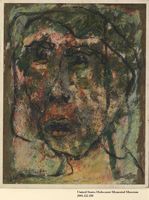
Halina Olomucki drawing
Object
Abstract portrait of a woman in black lines with orange tears and green background, mounted on cardboard
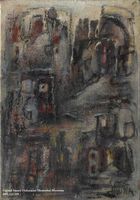
Halina Olomucki drawing
Object
Abstract image of geometric shapes that appear to be buildings in dark lines and colors, mounted on cardboard

Halina Olomucki drawing
Object
Abstract portrait of a woman with long hair, diagonal line across surface and multi-colored background, mounted on cardboard
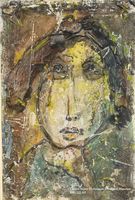
Halina Olomucki drawing
Object
Abstract portrait of a woman with short dark hair, yellow and blue-green background, mounted on cardboard

Halina Olomucki drawing
Object
Abstract image of six standing thin figures, blue and green background, mounted on cardboard
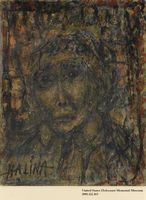
Halina Olomucki drawing
Object
Abstract portrait of a person with dark eyes and sunken cheeks, red border and yellow-green background, mounted on cardboard
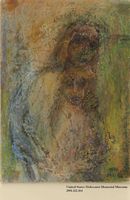
Halina Olomucki drawing
Object
Abstract image of a standing woman holding a child in front of her, green and orange background, mounted on cardboard

Halina Olomucki drawing
Object
Abstract image of a figure drawn in black ink lines with a mottled dark green background, mounted on cardboard
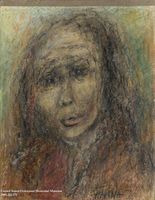
Halina Olomucki drawing
Object
Abstract portrait of a woman with long dark hair, red lips and blue and orange background, mounted on cardboard

Halina Olomucki drawing
Object
Abstract portrait of a woman with long hair, green and yellow background, red dots around neck, mounted on cardboard
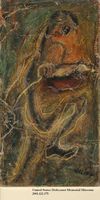
Halina Olomucki drawing
Object
Abstract image of a running figure shown in yellow outlines holding a red bowl, mounted on cardboard (uneven surface)
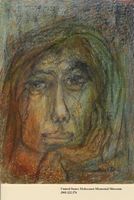
Halina Olomucki drawing
Object
Abstract image of a woman leaning her head on her hand, orange and blue-green background, mounted on cardboard
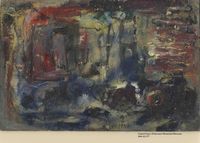
Halina Olomucki drawing
Object
Abstract image of geometric forms representing buildings, blue, red and yellow background, mounted on cardboard
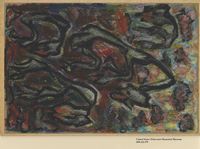
Halina Olomucki drawing
Object
Abstract image of four hunched over figures, cloud-like forms above, mounted on cardboard

Halina Olomucki drawing
Object
Abstract image of a group of people moving from building-like structures on the left towards a mountain-like structure on the right, mounted on cardboard
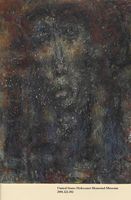
Halina Olomucki drawing
Object
Abstract portrait of a woman with long hair and down-turned mouth, blends in with multi-colored background, mounted on cardboard

Halina Olomucki drawing
Object
Abstract image of a group of buildings with figures in front, some in green and some in black, orange-red background, mounted on cardboard
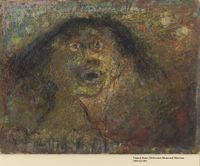
Halina Olomucki drawing
Object
Abstract portrait of a woman with dark hair pointing out sideways and large round eyes and mouth, mounted on cardboard

Halina Olomucki drawing
Object
Abstract image of woman with long arms out to the sides, yellow sun on left, multi-colored background, mounted on cardboard.

Halina Olomucki drawing
Object
Abstract image of a hunched over figure shown in orange lines with large red-orange structure on the left and barbed wire in front, mounted on cardboard
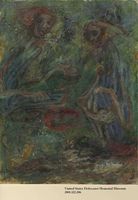
Halina Olomucki drawing
Object
Abstract image of two thin women wearing kercheifs, red bowl in center, mounted on cardboard

Halina Olomucki drawing
Object
Abstract image of a woman leaning her chin on her hand and another figure behind her, blue background, mounted on cardboard
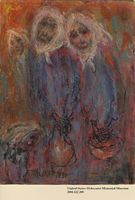
Halina Olomucki drawing
Object
Abstract image of four women wearing kercheifs and carrying large parcels, orange and red background, mounted on cardboard

Halina Olomucki drawing
Object
Abstract image of three ghost-like figures shown in red, blue background, mounted on cardboard

Halina Olomucki drawing
Object
Abstract image of a woman holding her hand to her mouth, building structures in the background, mounted on cardboard
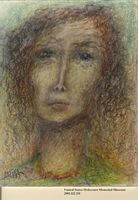
Halina Olomucki drawing
Object
Abstract portrait of a woman with curly hair, wearing a red necklace, blue background, mounted on cardboard

Halina Olomucki drawing
Object
Abstract image of six crouching and huddled over figures with buildings, blue-green wash background, mounted on cardboard

Halina Olomucki drawing
Object
Abstract portrait of a woman with dark eyes and thin neck, mounted on cardboard

Halina Olomucki drawing
Object
Abstract portrait of a woman with large opened mouth and worried eyes, mounted on cardboard
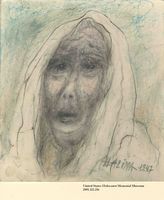
Halina Olomucki drawing
Object
Abstract portrait of a woman with dark eyes and haggard expression, blue background, mounted on cardboard
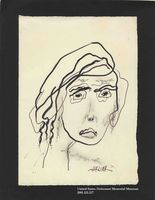
Halina Olomucki drawing
Object
Abstract portrait of a woman with large dark eyes and down turned mouth, drawn in simple lines, mounted on construction paper
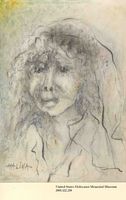
Halina Olomucki drawing
Object
Abstract portrait of a girl with haggard expression, yellow sun in top left corner, mounted on cardboard

Halina Olomucki drawing
Object
Abstract portrait of a woman with large hollow eyes, light blue background, mounted on cardboard

Halina Olomucki drawing
Object
Abstract image of a woman clutching a baby in her arms, drawn in simple black lines
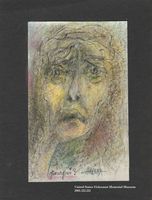
Halina Olomucki drawing
Object
Abstract image of a woman with an anguished expression, multi-colored background, mounted on construction paper
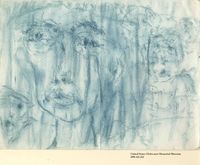
Halina Olomucki drawing
Object
Abstract image showing many faces drawn in a loose style, vertical lines in front (fold down center)
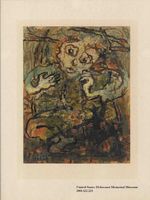
Halina Olomucki drawing
Object
Abstract image of a sitting child with round face, eyes and mouth, mounted on cardboard
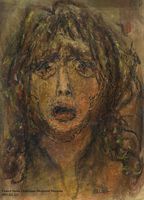
Halina Olomucki drawing
Object
Abstract portrait of a girl with long curly hair, dark eyes and opened mouth, orange and green background
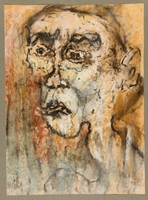
Halina Olomucki drawing
Object
Abstract portrait of an emaciated man with large dark eyes, framed under glass
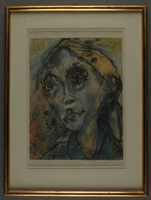
Halina Olomucki painting
Object
Abstract portrait of a woman with light-colored hair and large round, dark eyes, framed under glass

Halina Olomucki painting
Object
Abstract image of a group of thin women with barbed wire in front, orange, red and green background, mounted on cardboard and framed.
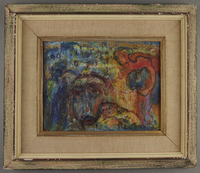
Halina Olomucki drawing
Object
Abstract image of a stooped over thin figure carrying a load on the right, large face in center and figure and buildings behind, mounted on cardboard and framed
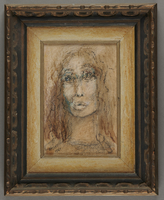
Halina Olomucki painting
Object
Portrait of a woman with long hair, blue details on face, mounted on cardboard and framed

Halina Olomucki drawing of a woman
Object
Abstract portrait of a woman long blond hair and round dark eyes, pink and white sun in upper left corner, mounted on cardboard and framed
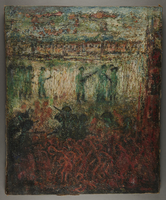
Halina Olomucki painting
Object
Abstract image of groups of people surrounded by military figures dressed in green and carrying guns, orange-red color below and blue-green color above, very thick paint layer, on stretcher (poor condition- canvas torn on edge).

Halina Olomucki painting
Object
Abstract image of a group of standing ghost-like figures holding red bowls to their sides, framed

Halina Olomucki painting
Object
Abstract image with two tall red chimneys on the right and a menorah-like object in the bottom left corner, blue sky above with yellow and blue suns, mounted on cardboard

Halina Olomucki drawing
Object
Abstract image of a standing central figure with a clinging child and a group of other children standing around, on stretcher (no frame), large patched central hole

Halina Olomucki painting
Object
Abstract portrait of a woman with large dark eyes, blue and green background, framed

Halina Olomucki painting
Object
Abstract image of a group of figures huddled together and traveling to the left, bright yellow sun in upper right corner, mounted on cardboard and framed
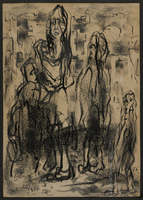
Halina Olomucki drawing
Object
Image of four standing figures with buildings in the background, sketchy black lines

Halina Olomucki drawing
Object
Image of a thin standing woman wearing a kercheif, buildings in background

Halina Olomucki drawing
Object
Abstract image of two thin women stooped over an x-shaped structure, on blue paper
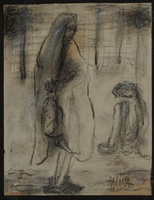
Halina Olomucki drawing
Object
Abstract image of a standing woman holding an object with a crouching figure in the background
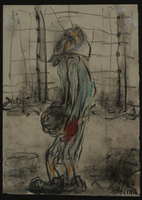
Halina Olomucki drawing
Object
Abstract image of a stooped over woman carrying a heavy item, wire fence behind
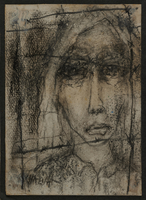
Halina Olomucki drawing
Object
Abstract portrait of a woman with long hair and dark eyes behind barbed wire

Halina Olomucki drawing
Object
Abstract image of two thin woman carrying a heavy load between them, wire fence behind

Halina Olomucki drawing
Object
Abstract image of a group of bent over, haggard figures, on blue paper

Halina Olomucki drawing
Object
Abstract image of a group of huddled figures moving to the left, on blue paper.

Halina Olomucki drawing
Object
Abstract image of a group of standing women holding large parcels, on blue paper.

Halina Olomucki drawing
Object
Abstract portrait of a thin old woman facing to the left, on blue paper.

Halina Olomucki drawing
Object
Abstract image of two stooped over women holding parcels, other figures in background.

Halina Olomucki drawing
Object
Abstract portrait of a person with haggard face, wearing a striped uniform.
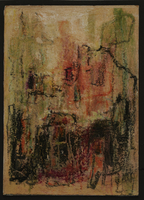
Halina Olomucki drawing
Object
Abstract image of a city with buildings in black and background with green, orange and red
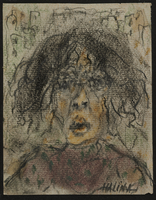
Halina Olomucki drawing
Object
Abstract portrait of a haggard woman with yellow face, green spotted dress and buildings in background.

Halina Olomucki drawing
Object
Abstract portrait of a woman with dark eyes and down turned mouth, drawn in black, sketchy lines
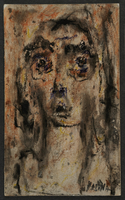
Halina Olomucki drawing
Object
Abstract portrait of a woman with long dark hair and round dark eyes, orange background.

Halina Olomucki drawing
Object
Abstract image of a stooped over woman carrying a parcel over her shoulder, buildings in the background and staircase on the left, orange and red background.
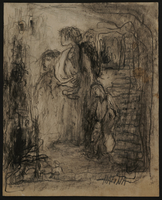
Halina Olomucki drawing
Object
Abstract image of a family standing in the center with a staircase to the right.
Halina Olomucki drawing
Object
Image of a group of standing people with Rabbi on the left, mounted on cardboard and construction paper
Halina Olomucki drawing
Object
Rectangular form; vertical format; black and white image of man staring out window of building that is in form of human skull
Halina Olomucki drawing
Object
Rectangular form; vertical format; interior scene, black and white image of figures lying in bunk beds and woman standing in middle of room with her hands in pockets of apron
Halina Olomucki drawing
Object
Rectangular form; vertical format; black and white exterior scene; in foreground, image of soldier standing with back to viewer while unclothed man stands in front of him; in background, image of group of unclothed figures and smoke stack
Halina Olomucki drawing
Object
Rectangular form; vertical format; interior scene, black and white image of group of figures sitting and lying on upper and lower wooden bunks
Halina Olomucki drawing
Object
Image of two walking women carrying parcels, mounted on construction paper

